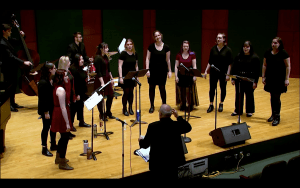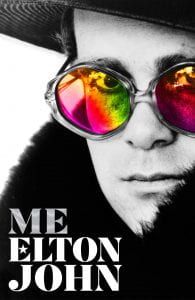The Ithaca College Jazz Vocal Repertory Ensemble offers a night filled with extraordinary talent and welcomed surprises for all music lovers to indulge in.
Improvisation in every form, the performance by the Jazz Vocal Repertory Ensemble had everything one could ask for. On the 27th of January 2020 the ensemble, home to Ithaca College, put on a fantastic show that music-lovers from all walks of life could enjoy. A time when blissful concertgoers could enjoy the privilege of attending in-person concerts on a regular basis without having the fear of being infected by a deadly virus. Unfortunately, we no longer have the same privilege, but alas we have learnt to accept this change and grown accustomed to watching recorded concerts from the comforts of our own homes. As luck would have it, the performance was recorded and is accessible for all to relish on the Ithaca College School of Music 2019-2020 Archive webpage. Even if you are a casual listener of Jazz, I can guarantee you will enjoy the talent and exuberant energy the ensemble exudes. Directed by the gifted John W. White, an active and involved member of the Ithaca college community who has clearly cultivated a special relationship with his musicians, the performance does not lack in any aspect.
Allow me to preface my remarks about the extraordinary talent this ensemble possess by describing how the concert opens: Prior to the concert the conductor and his students spontaneously decided to ‘add a tune’ for the rhythm section, in light of the fact that it was a jazz concert. Of course, every jazz concert must contain at least one piece for the rhythm section, so this last-minute revelation was really no surprise. In case you are convinced that the spontaneity was a ploy to paint the musicians in a more talented light and impress the audience, let that doubt be put to rest as the piece was not even included in the program. With precise instruction to the ensemble, consisting of a piano, upright bass, and drum set, they proceed to perform ‘All The Things You Are’ perfectly, hitting every note with unmatched precision, leaving us to question the nature of their being; perhaps they are robots and the piece was programmed into their very being? This explanation may offer more merit than the idea that they are simply human like the rest of us. Each musician seems to have masterful control over their instrument, always on time and in tune. Throughout their performance, they glance at one another, as if speaking their own secret language through gestures and facial expressions, in order to communicate cues. An impressive feat given the fact that they are not paying full attention to their instrument when attempting to perform a rather musically and technically demanding piece. They casually trade improvisatory solos among themselves with such grace and ease that one can only assume they are all being controlled by a singular higher being. Every soloist has an unparalleled accuracy with pitch and sharp cut offs. Each solo speaks to the mastery and versatility of each member of the ensemble, demonstrating to the audience the immense amount of talent packed onto the tiny stage.
After the unplanned detour, the scheduled program begins as the jazz vocalists walk on, immediately commanding control of the stage. An ensemble of 10 female vocalists stand confidently in front of their music stands, ready to amaze. Starting with ‘One Note Samba’ by Antonio Carlos Jobim, the performers sway around enthusiastically to the driving beat of the music drenched in Latin flavor. The ensemble enters in unity, singing with clear diction and outstanding pitch. Sharp cutoffs and solid entrances make the performance professional-esque. Throughout the piece, they add musical variation by performing intriguing harmonies that include octaves and other, more complex, intervals. As soon as we are left feeling satiated with all the musical motifs that had been offered, a few different vocalists perform unique solos. Not just any type of solos, scat singing— vocal improvisation with wordless vocables, nonsense syllables or without words at all— a considerably harder form of singing. The soloists, one by one, walk up to center stage and start improvising their hearts out. Making up vocal melodies on the spot with an unparalleled amount of confidence and accuracy, leaving the audience in complete awe.
As the applause echo through the hall, White introduces the next song, ‘Route 66’ by Bobby Troop and promptly exits the stage. The piece opens with an emphatic bass solo, setting the tone and tempo for the rest of the performance. As the low notes reverberate throughout the concert hall, the bass is quickly joined by the drums and piano, setting the stage for the vocal ensemble to enter. Upon entrance the vocalists show off their expansive range by singing rather low notes. With fun little scoops and precise cut offs, the performance was definitely an enjoyable one. Like the last number, there was a section of scat singing once again but this time, with a surprise element. White jumps into the performance with some of his own improvised melodies from off-stage, leaving the audience completely stunned. Suddenly, there was an impromptu call and response happening between White and the three soloists on stage; it seconds the whole audience is in on it on-time claps and everyone singing, creating an energetic and delightful atmosphere. White seamlessly conducts the ensemble to end the improv section and proceed with the full-fledged chorale arrangement which is perfectly executed musicians and singers.
We then transition to the next piece, “Taking A Chance On Love.” It opens with a soloist, whose voice is strong yet tender, accompanied by lavish chords on the piano. Almost lullaby-like, the tranquil duo might just make your eyes start to fell heavy and induce a deep slumber. The jazz sound we have grown accustomed to then makes a prompt re-entry, knocking us back in our chairs. Instantly, we start to hear a chorus of voices singing jazz-like harmonies escorted by the driving rhythm section. For those who enjoy jazz and easy listening, this would be perfect to listen to. Upon completion, White converses with the audience briefly and comes up with a great segue into introducing the next song on the program, ‘There Is No Greater Love’ by Marty Symes & Isham Jones. Though the tempo seems to be quite erratic during the introduction, it seems to become steadier and easier to follow once the vocalists join in. Like all the other songs, the audience are left to the devices of the heavenly chorus accompanied with harmonies. Finally, we have a soloist perform her own vocal improvisation making use of random syllables and occasionally lyrics. From the depths of the tenor range to the sky-scarping altitude of the soprano range, her vocal scope seemed to be endless. It was so magnificent that the audience felt compelled to accompany her with claps as a vote of appreciation.
For the final number, White decided to end with an a cappella performance , Toyland by Glen MacDonaugh & Victor Herbert, in order to really emphasize the talent of his vocal ensemble. After giving a brief history lesson, and so graciously warning the audience that there would be a quiz on it, White gives a starting note and raises his hands to indicate the beginning of the end. What would easily be the most impressive vocal performance was to proceed. The ensemble had perfect diction which created a blend like no other; it was as if all their voices were combined together to form a single sound. Furthermore, they managed to remain on pitch throughout the performance, without the assistance of any external instrument, which in itself, is a spectacular feat. The melodies and countermelodies move effortlessly in unison, complimenting each other at every turn. With dynamic contrast and perfect timing, the piece had all the ingredients necessary to make it the highlight of the concert. The perfect end to a night filled with outstanding music. Whether or not you are fan of jazz, I can promise you that this ensemble will bring you copious amounts of joy.
Watch the performance here





